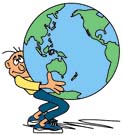

Goals:
1. To find a body of water using longitude and latitude coordinates, to write the appropriate coordinates for a given body of water, and to understand the importance of using longitude and latitude.
2. To familiarize themselves with bodies of water at numerous geographic locations around the world.
Resources:
Perham, M., & Steele, P. (1992). The Children’s Illustrated World Atlas.
Philadelphia: Courage Books.
White, C. (1994). "You Can Find it!" gopher://ericir.syr.edu:70/00/Lesson/Subject/SocialStudies/cecsst.133
Materials:
For students: longitude and latitude coordinate problems, world map, world atlas, and globe.
For teacher: A large world map, and overhead projector.
Time: 90 minutes
Procedure:
1. Begin discussion on longitude and latitude. Why are the lines
important for navigation of ships, airplanes, or finding location.
How does this differ from the 1820’s slave ships’
navigation.
2. Use the overhead projector to show directions on how to use
longitude and latitude. Also, discuss how lines running horizontally
have either north or south degrees and are called latitude. The lines
vertically have either east or west degrees and are called
longitude.
3. After giving directions on how to use coordinates and degrees for
latitude and longitude, each student will work in groups to find
answers to a set of individual longitude and latitude problems. The
problems contain eight bodies of water and the students must give the
longitude and latitude coordinates of each using egrees and
direction. Also, eight sets of coordinates will be included and the
students need to name the body of water that represents the
coordinates. Atlases and globes will be used.
Assessment:
1. Criteria for success will be determined by 85 to 90 percent
correct on problems using longitude and latitude coordinates, and
successfully writing appropriate coordinates.
2. Students will discover through a variety of problems which bodies
of water lie within location of where they live.
(Problems attached to lesson plan)
3. Criteria for success will be 85 to 90 percent correct on
completion of all latitude and longitude problems.
Curricular Strands and Major Concepts:
1. Social Studies- locating, naming, and familiarizing students
with bodies of water around the world. Use of maps, atlases, and
globes.
2. Math- converting numbers into coordinates of latitude and
longitude.
Extensions:
1. Determine coordinates of bodies of water and locations used by
slaves during the Atlantic slave trade.
2. More practice using longitude and latitude coordinates.
3. Research and discuss technology and/or hand
held devices used for finding longitude and latitude.